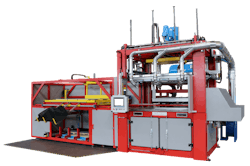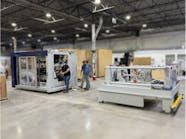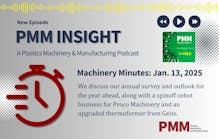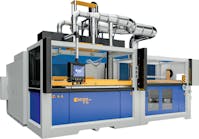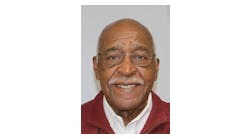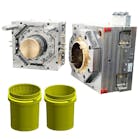Energy efficiency and automation will become more prevalent in thermoforming equipment as 2030 approaches according to two major OEMs, Cannon and Gabler.
“In many of our current markets, we are seeing a trend toward investigating and adapting more equipment technology that not only performs the plastic part thermoforming tasks, but also takes into account efficiencies that are very common in European manufacturing, like enclosed mold cabinets for heat efficiencies, heating element mapping controls, and material sag controls,” said Eric Burrill, thermoforming equipment product manager for Cannon USA, the North American company of the Cannon Group, which is headquartered in Italy.
All these improvements are geared toward making the equipment more efficient and safer to operate, he said.
“In addition, we are working on advanced capabilities, for example a smart material scan system [that is] able to read the data [on barcodes] of plastic sheets being loaded and automatically adjust the operating parameters of the machine, optimizing the heat mapping and temperature, adjusting the plate opening, and altogether minimizing the time spent in part-to-part transition,” he said.
Stephan Gotschol, area sales manager for Gabler Thermoform, agreed that energy efficiency is one of the demands for new machinery.
“In our opinion, market requirements will move in the direction of resource and energy efficiency, environmental protection and automation,” Gotschol said. “At the same time, we can see that a trend toward smaller, flexible machines as well as large and specialized systems is emerging.”
Automation and Industry 4.0 capabilities will grow
“As the industry moves forward, the rise in demand for high-flexibility production will promote equipment configurations focused on quick part and mold changeovers,” Burrill said.
Current equipment often requires long changeover procedures that can require several hours to set up for production of a new part. In addition, the changeovers can result in substantial material scrap costs, Burrill said.
“Manufacturers are looking to be efficient with time and labor,” he said. “We are expecting to see more robot integration into cell production areas, focused on removing the formed part from the automatic unloading system to a cooling station, if required, and then on to the CNC machine, creating a finished part to then be palletized and ready for shipment.”
Fast job changeover and robot integration in equipment lines are strengths of Cannon’s integrated solutions, Burrill said.
He said he foresees automation as essential for producers who adopt a just-in-time production concept.
Gotschol also predicted increased demand for automation as processors look to reduce human labor. Gotschol said customers are looking for machines that can operate with less human intervention.
“In the future, producers will increasingly place demands on the manufacturer regarding the ‘intelligence’ of a machine,” Gotschol said. “This concerns, for example, the degree of automation of a machine with regard to error detection and error correction or reporting in order to use less-trained personnel or not to have to train them so cost-intensively.”
The availability of user-friendly HMIs and control units will be a high priority, he said.
Auxiliary equipment will become more closely integrated with primary processing equipment.
“We expect more and more auxiliary devices to become part of the primary processing machine in the future,” Gotschol said. “The topic of automation and networking of the machines with each other plays a major role here. Both thermoforming machines and auxiliary equipment can be better controlled and used more efficiently.”
The networking of devices also may involve sharing information in the cloud. “In the course of process and control optimization, the topic of a cloud-based user interface for the use of shared data from an extruder, thermoforming machine, etc., is becoming more and more important and is one of the main influencing factors in the automation process with the aim of further reducing personnel costs as a fixed cost block,” Gotschol said.
Demand for less downtime
Processors will demand premium after-sales services from their equipment supplier, Burrill said. As an example of what steps the company has recently taken, Burrill said Cannon at the 2019 K-Show announced it was it was launching remote service assistance using Google technology.
“Wearing Google glasses, the customer will be connected in real-time with Cannon USA’s technical team, [who will be] able to guide the troubleshooting operation,” Burrill said. “The value of this new service is shown higher today with current worldwide travel restrictions.”
The technology can also be used to train new staff, teaching them the best operating procedures for the equipment with the goal of reducing the learning curve.
Gotschol said producers want to be able to increase service intervals and reduce downtimes to a minimum.
Bruce Geiselman, senior staff reporter
For more information:
Cannon USA Inc., Cranberry Township, Pa., 724-772-5600, www.cannonusa.com
Gabler North America, Louisville, Ky., 989-615-6365, www.gabler-thermoform.com
Bruce Geiselman | Senior Staff Reporter
Senior Staff Reporter Bruce Geiselman covers extrusion, blow molding, additive manufacturing, automation and end markets including automotive and packaging. He also writes features, including In Other Words and Problem Solved, for Plastics Machinery & Manufacturing, Plastics Recycling and The Journal of Blow Molding. He has extensive experience in daily and magazine journalism.

